The demand for glass cosmetic bottles in Japan is expected to grow from USD 154.7 billion in 2025 to USD 200.5 billion by 2035, reflecting a CAGR of 2.6%. Glass cosmetic bottles are favored in the beauty and personal care industry for their premium look, aesthetic appeal, and eco-friendly attributes. As the Japanese beauty market continues to emphasize premium quality and sustainability, the demand for glass packaging remains strong. The increasing focus on clean beauty, high-end skincare, and luxury fragrances further boosts demand for glass bottles, as they provide better protection for sensitive formulations and enhanced brand perception.
The growth in this market is also supported by the trend toward sustainable packaging. With increasing concerns about plastic pollution, both consumers and companies are shifting towards more environmentally friendly alternatives like glass. The growing popularity of refillable glass bottles and the rise of eco-conscious consumers are expected to contribute to the sustained demand for glass packaging in the cosmetics sector over the forecast period. Furthermore, advancements in lightweight glass technology and innovative designs are expected to maintain the appeal of glass cosmetic bottles in Japan.
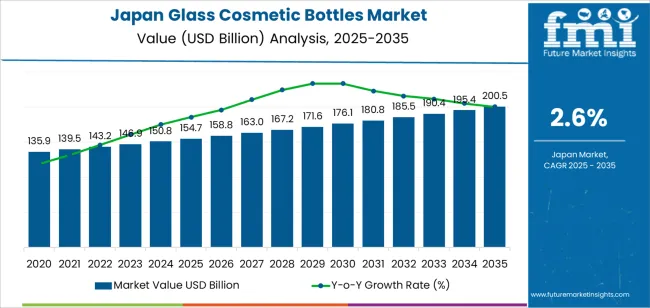
The saturation point analysis for glass cosmetic bottles in Japan indicates that while demand will continue to grow, the rate of growth is expected to slow down as the market matures. From 2025 to 2030, demand will grow from USD 154.7 billion to USD 176.1 billion, with an increase of USD 21.4 billion. This early growth reflects the ongoing demand for premium and sustainable packaging in the cosmetics industry. However, after the initial years of steady growth, the market will start to approach its saturation point, particularly as the market for glass bottles becomes more established in the mid-to-premium sectors of beauty and personal care.
The saturation point is likely to occur around 2030-2032, as the market reaches its peak in penetration and adoption. From 2030 to 2035, growth from USD 176.1 billion to USD 200.5 billion will continue, but the rate of increase will slow down, adding USD 24.4 billion in value over the final five years. This slowdown in growth will be driven by market maturity, with the widespread adoption of glass packaging already achieved by major beauty brands. While innovation and eco-friendly packaging trends will sustain demand, the market will likely become less responsive to rapid increases in volume as refillable systems, sustainability initiatives, and packaging innovation become standard in the industry. Therefore, the market will experience stable but slower growth as it reaches its saturation point by the mid-2030s.
| Metric | Value |
|---|---|
| Sales Value (2025) | USD 154.7 billion |
| Forecast Value (2035) | USD 200.5 billion |
| Forecast CAGR (2025-2035) | 2.6% |
Demand for glass cosmetic bottles in Japan is increasing as beauty and personal care brands emphasise premium packaging, sustainability and formulation integrity. Glass containers are preferred for high end skincare, serums and fragrances due to their inert properties, upscale appearance and perceived value. Japanese consumers are particularly sensitive to packaging aesthetics, and brands seeking to position products as luxury or technologically advanced often select glass to reinforce quality and brand identity. At the same time, regulatory and environmental factors support glass adoption because it is infinitely recyclable and aligns with Japan's strong waste recycling culture and packaging material regulations.
Another factor driving growth is the evolution of consumer expectations and retail channels. As digital commerce and global travel retail expand, brands use glass bottles to enhance the unboxing experience and visual appeal of products. Innovations in lightweight glass, refined finishes and custom decorative techniques add further differentiation in the market. Despite higher costs and the risk of breakage compared with plastic alternatives, the convergence of luxury branding, sustainability priorities and premium functionality sustains demand for glass cosmetic bottles in Japan.
The demand for glass cosmetic bottles in Japan is driven by two key factors: end-use industry and material type. The leading end-use industry is skincare, which accounts for 45% of the market share, while the dominant material type is borosilicate glass, holding 55% of the market share. Glass packaging is highly valued in the cosmetics sector for its premium aesthetic appeal, durability, and ability to preserve product integrity. As demand for high-quality skincare products and sustainable packaging grows, borosilicate glass bottles are gaining popularity due to their resistance to chemical interactions, making them ideal for delicate formulations.
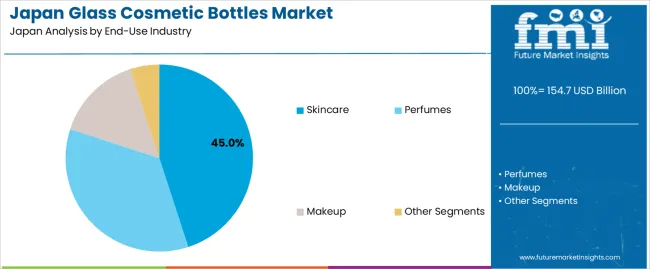
The skincare industry is the largest end-user of glass cosmetic bottles in Japan, capturing 45% of the market share. The preference for glass packaging in skincare products is driven by consumer demand for high-end, premium products that convey luxury and quality. Glass bottles are ideal for packaging skincare products such as serums, oils, creams, and toners because they are chemically inert and do not react with active ingredients, preserving the integrity and efficacy of the formulation.
In Japan, a market known for its advanced skincare products and emphasis on high-quality ingredients, glass packaging is seen as an important factor in conveying trust and premium quality. Additionally, with growing concerns over sustainability, glass packaging is valued for its recyclability and eco-friendliness. As consumers increasingly seek natural, high-performance skincare products, the demand for glass cosmetic bottles, particularly in the skincare sector, will continue to rise, reinforcing the industry's position as the leading end-use segment.

Borosilicate glass is the leading material type for glass cosmetic bottles in Japan, holding 55% of the market share. Borosilicate glass is preferred for its superior durability, resistance to thermal shock, and chemical inertness, making it the ideal choice for high-end cosmetic products, especially those with active ingredients sensitive to chemical reactions. It is particularly suitable for skincare, perfumes, and makeup products, where maintaining the integrity of the formulation is critical.
Borosilicate glass bottles provide a premium appearance and feel, which is important in the cosmetics industry, where packaging is often just as important as the product itself. Its ability to resist heat and UV radiation ensures that products remain stable and effective over time, even under varying environmental conditions. As the demand for sustainable, high-quality packaging continues to grow in the cosmetic sector, borosilicate glass remains the preferred material for packaging delicate and high-value cosmetic products, cementing its leadership in the Japanese market.
Demand for glass cosmetic bottles in Japan is influenced by the premium positioning of beauty products, strong consumer preference for high quality packaging, and increasing focus on sustainability and recycling. Glass offers an upscale aesthetic, chemical inertness and recyclability, which aligns with values of Japanese brands and consumers. At the same time, cost pressures, competition from lighter materials like plastics and the need for manufacturing precision shape how fast glass bottle adoption spreads in the Japanese cosmetics sector.
Several factors fuel growth in this market. First, brands in Japan are shifting toward premium skincare, serums, fragrances and luxury cosmetics, and use glass bottles to enhance perceived value and quality. Second, consumer awareness of material safety and eco friendliness is rising, leading to preference for glass over plastics in personal care and beauty packaging. Third, innovations in lightweight, decorative glass bottles such as embossed finishes, colour glass and special closures offer differentiation in Japan’s sophisticated beauty market. Fourth, regulatory and waste management frameworks encourage use of recyclable materials, boosting glass packaging in cosmetics.
Despite positive trends, the market faces several constraints. Glass bottles cost more to produce and transport than many plastic alternatives, which can restrain adoption especially in mass market product lines. The heavier weight and fragility of glass increase logistics and breakage risk, which can deter brands with broad distribution or export oriented supply chains. Additionally, some brands favour lightweight or refillable plastic systems to meet convenience and cost efficiency demands, limiting substitution toward glass. Finally, to maintain precision aesthetics and high finish quality in Japan, manufacturers must invest in advanced tooling and decoration, which may slow entry or volume expansion.
Emerging trends in Japan’s glass cosmetic bottle market include growing use of glass in high end skincare and fragrance segments where branding and material integrity matter most. There is increased adoption of lightweight glass and thin walled designs to reduce weight and cost while retaining premium feel. Sustainability drives are evident: Japanese brands emphasise glass recyclability, use of recycled cullet and minimal packaging waste. Decorative and functional enhancements like dropper bottles, airless pumps and special coatings are becoming more common in glass bottles. Finally, regional manufacturing and customisation services are rising to meet Japanese brands’ need for unique shapes, finishes and small production runs.
The demand for glass cosmetic bottles in Japan is driven by the increasing consumer preference for premium, eco-friendly packaging, particularly in the cosmetics and personal care industries. Glass bottles are valued for their aesthetic appeal, durability, and ability to preserve the integrity of cosmetic products. As consumers become more conscious of sustainability, brands are shifting towards glass packaging to meet environmental concerns. Japan’s strong beauty and skincare industry, combined with the growing trend of luxury and sustainable packaging, further boosts the demand for glass cosmetic bottles.
Regional variations in demand are influenced by factors such as population density, the presence of cosmetic manufacturers, and consumer preferences for high-end beauty products. The Kanto region leads in demand, supported by its large population and concentration of cosmetic companies, while other regions like Kyushu & Okinawa, Kinki, and Chubu follow with steady adoption. This analysis explores the regional drivers of glass cosmetic bottle demand in Japan.
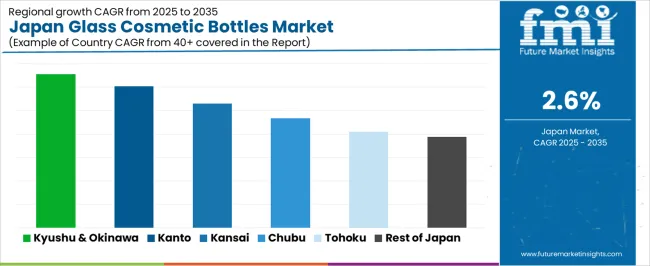
| Region | CAGR (2025-2035) |
|---|---|
| Kyushu & Okinawa | 3.3% |
| Kanto | 3% |
| Kinki | 2.7% |
| Chubu | 2.3% |
| Tohoku | 2% |
| Rest of Japan | 1.9% |
Kyushu & Okinawa leads Japan in the demand for glass cosmetic bottles with a CAGR of 3.3%. The region’s growing interest in premium beauty products, particularly in skincare and cosmetics, is a key driver for this demand. Glass bottles are favored for their luxurious appearance and ability to maintain product quality, which aligns well with the increasing demand for high-end beauty products in the region.
Kyushu & Okinawa’s strong agricultural base, particularly in the production of natural skincare ingredients such as herbal extracts, also contributes to the need for quality packaging solutions like glass bottles. The region's focus on eco-friendly packaging and sustainability initiatives, especially in the beauty and skincare sectors, supports the growing preference for glass over plastic. As the demand for natural and luxury beauty products increases, the adoption of glass cosmetic bottles in Kyushu & Okinawa is expected to continue growing.
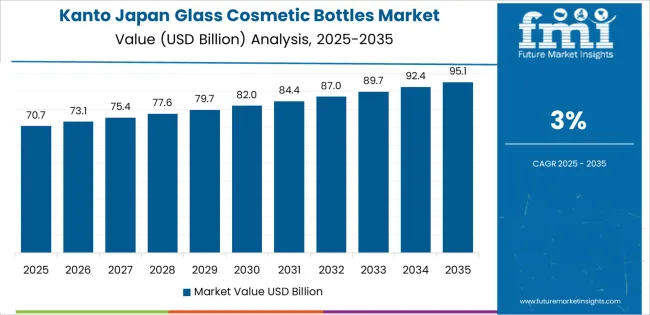
The Kanto region shows strong demand with a CAGR of 3.0%. As Japan’s largest economic hub, Kanto, including Tokyo, drives the demand for glass cosmetic bottles due to the high concentration of cosmetic brands, luxury beauty product manufacturers, and retailers. The region’s large, affluent population is a key consumer base for high-quality skincare and cosmetics, where glass bottles are used for packaging premium products.
The growing trend of sustainability in Kanto, along with increasing awareness of environmental impacts, has pushed many cosmetic brands to adopt glass packaging to meet consumer expectations. Additionally, Tokyo’s position as a fashion and beauty capital has increased the demand for visually appealing and luxurious packaging like glass. As the region continues to innovate in beauty and skincare products, demand for glass cosmetic bottles will continue to rise.
The Kinki region demonstrates a steady CAGR of 2.7%. As one of Japan's major urban and industrial centers, Kinki, which includes Osaka and Kyoto, has a growing beauty and personal care industry. While the region is home to many manufacturing facilities and distribution networks, the demand for glass cosmetic bottles is steady rather than explosive, driven primarily by the premium beauty and skincare markets.
The region's strong retail infrastructure and concentration of beauty consumers continue to sustain steady demand for high-end cosmetics, where glass packaging is preferred. Kinki's focus on sustainability and eco-friendly practices also supports the shift toward glass packaging, which aligns with consumer preferences for environmentally conscious choices. As the demand for luxury and organic beauty products increases, the need for glass bottles in the Kinki region will continue to see steady growth.

The Chubu region shows a moderate CAGR of 2.3%. Chubu, home to Nagoya and other industrial centers, has a diverse manufacturing base, including beauty and skincare production. While the region's overall demand for glass cosmetic bottles is lower than that of the Kanto and Kyushu regions, steady growth in the beauty and personal care sector, particularly in mid-tier brands, is contributing to this demand.
Chubu’s growing focus on high-quality, sustainable packaging solutions for beauty products and skincare is also supporting the gradual increase in the adoption of glass bottles. The region’s strong emphasis on manufacturing efficiency and eco-friendly practices in the consumer goods sector further drives the demand for glass packaging as companies aim to meet sustainability goals.
Tohoku shows a modest CAGR of 2.0%, while the Rest of Japan follows with 1.9%. These regions experience slower growth in the demand for glass cosmetic bottles due to lower overall consumption of premium beauty products compared to more urbanized regions like Kanto and Kyushu & Okinawa. However, there is still steady demand for glass packaging, particularly for local and regional beauty brands.
The lower growth rate in these areas is partly due to less concentration of large-scale cosmetic manufacturing and retail outlets. Nevertheless, as consumer awareness of sustainable packaging increases and more eco-conscious products are developed, these regions will see continued adoption of glass bottles, although at a slower pace. As the market for natural and organic beauty products expands, demand for glass cosmetic bottles will gradually grow in these regions.
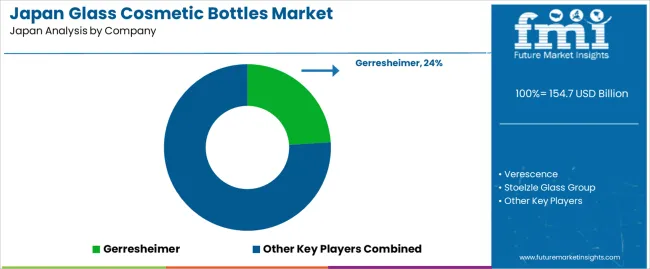
Demand for glass cosmetic bottles in Japan remains strong due to the country’s growing focus on premium packaging for cosmetics, skincare, and personal care products. Companies such as Gerresheimer (holding approximately 24% market share), Verescence, Stoelzle Glass Group, and Vidrala are key players in this market. The demand is driven by consumers' preference for high-quality, aesthetically appealing, and environmentally friendly packaging solutions. Japanese consumers, particularly in the beauty industry, value glass for its premium look, chemical inertness, and sustainability.
Competition in the Japanese market is centered on product quality, customization, and environmental considerations. One key focus is developing glass bottles that provide a premium appearance while being lightweight and durable to reduce transportation costs. Another strategy involves offering a wide range of customization options, such as unique shapes, colors, and decorative features, to cater to brands seeking differentiation in a crowded market.
Companies are also prioritizing sustainability, offering bottles made from recycled glass or promoting recyclability to meet increasing environmental regulations and consumer demand for eco-friendly packaging. Marketing materials often highlight features like design flexibility, customization options, environmental impact, and glass quality. By aligning their products with the evolving needs of the Japanese beauty and personal care industries, these companies aim to strengthen their market position in the glass cosmetic bottle sector.
Takemoto Yohki Co., Ltd.
Gerresheimer AG
Verescence
Stoelzle Glass Group
Toyoseikan Co., Ltd.
Nihon Yamamura Glass Co., Ltd.
| Items | Details |
|---|---|
| Quantitative Units | USD Billion |
| Regions Covered | Japan |
| End-Use Industry | Skincare, Perfumes, Makeup, Other Segments |
| Material Type | Borosilicate glass, Soda-lime glass, High-flint, Recycled glass |
| Key Companies Profiled | Gerresheimer, Verescence, Stoelzle Glass Group, Vidrala |
| Additional Attributes | The market analysis includes dollar sales by material type and end-use industry categories. It also covers regional demand trends in Japan, driven by the growth of skincare, perfume, and luxury makeup industries. The competitive landscape focuses on key manufacturers in the glass cosmetic bottles market, with innovations in glass production techniques and sustainable packaging. Trends in the increasing demand for eco-friendly packaging solutions are explored, along with advancements in glass recycling and product design. |
The global demand for glass cosmetic bottles in japan is estimated to be valued at USD 154.7 billion in 2025.
The market size for the demand for glass cosmetic bottles in japan is projected to reach USD 200.5 billion by 2035.
The demand for glass cosmetic bottles in japan is expected to grow at a 2.6% CAGR between 2025 and 2035.
The key product types in demand for glass cosmetic bottles in japan are skincare, perfumes, makeup and other segments.
In terms of material type , borosilicate glass segment to command 55.0% share in the demand for glass cosmetic bottles in japan in 2025.






Our Research Products

The "Full Research Suite" delivers actionable market intel, deep dives on markets or technologies, so clients act faster, cut risk, and unlock growth.

The Leaderboard benchmarks and ranks top vendors, classifying them as Established Leaders, Leading Challengers, or Disruptors & Challengers.

Locates where complements amplify value and substitutes erode it, forecasting net impact by horizon

We deliver granular, decision-grade intel: market sizing, 5-year forecasts, pricing, adoption, usage, revenue, and operational KPIs—plus competitor tracking, regulation, and value chains—across 60 countries broadly.

Spot the shifts before they hit your P&L. We track inflection points, adoption curves, pricing moves, and ecosystem plays to show where demand is heading, why it is changing, and what to do next across high-growth markets and disruptive tech

Real-time reads of user behavior. We track shifting priorities, perceptions of today’s and next-gen services, and provider experience, then pace how fast tech moves from trial to adoption, blending buyer, consumer, and channel inputs with social signals (#WhySwitch, #UX).

Partner with our analyst team to build a custom report designed around your business priorities. From analysing market trends to assessing competitors or crafting bespoke datasets, we tailor insights to your needs.
Supplier Intelligence
Discovery & Profiling
Capacity & Footprint
Performance & Risk
Compliance & Governance
Commercial Readiness
Who Supplies Whom
Scorecards & Shortlists
Playbooks & Docs
Category Intelligence
Definition & Scope
Demand & Use Cases
Cost Drivers
Market Structure
Supply Chain Map
Trade & Policy
Operating Norms
Deliverables
Buyer Intelligence
Account Basics
Spend & Scope
Procurement Model
Vendor Requirements
Terms & Policies
Entry Strategy
Pain Points & Triggers
Outputs
Pricing Analysis
Benchmarks
Trends
Should-Cost
Indexation
Landed Cost
Commercial Terms
Deliverables
Brand Analysis
Positioning & Value Prop
Share & Presence
Customer Evidence
Go-to-Market
Digital & Reputation
Compliance & Trust
KPIs & Gaps
Outputs
Full Research Suite comprises of:
Market outlook & trends analysis
Interviews & case studies
Strategic recommendations
Vendor profiles & capabilities analysis
5-year forecasts
8 regions and 60+ country-level data splits
Market segment data splits
12 months of continuous data updates
DELIVERED AS:
PDF EXCEL ONLINE
Demand Signal Repository Solutions Market Size and Share Forecast Outlook 2025 to 2035
Demand Side Management Market Size and Share Forecast Outlook 2025 to 2035
Demand Response Market Analysis - Size, Share, and Forecast Outlook 2025 to 2035
North America Shipping Supplies Market Trends – Innovations & Growth 2024-2034
Demand of Kozani Saffron in Greece Analysis - Size, Share & Forecast 2025 to 2035
Demand of No-acid Whey Strained Dairy Processing Concepts in European Union Size and Share Forecast Outlook 2025 to 2035
Demand for Bronte Pistachio in Italy Analysis - Size, Share & Forecast 2025 to 2035
Demand and Trend Analysis of Gaming Monitor in Western Europe Size and Share Forecast Outlook 2025 to 2035
Demand and Trend Analysis of Gaming Monitor in Korea Size and Share Forecast Outlook 2025 to 2035
Demand and Trend Analysis of Gaming Monitor in Japan Size and Share Forecast Outlook 2025 to 2035
Glycine Soja (Soybean) Seed Extract Market Size and Share Forecast Outlook 2025 to 2035
Demand and Trend Analysis of Yeast in Japan - Size, Share, and Forecast Outlook 2025 to 2035
Demand of Pistachio-based desserts & ingredients in France Analysis - Size, Share & Forecast 2025 to 2035
Western Europe Men’s Skincare Market Analysis – Forecast 2023-2033
Demand and Trends Analysis of Stevia in Japan Size and Share Forecast Outlook 2025 to 2035
Japan Women’s Intimate Care Market Trends – Growth & Forecast 2024-2034
Demand and Trend Analysis of Fabric Stain Remover in Korea Size and Share Forecast Outlook 2025 to 2035
Demand and Sales Analysis of Paper Cup in Korea Size and Share Forecast Outlook 2025 to 2035
Demand and Sales Analysis of Paper Cup in Western Europe Size and Share Forecast Outlook 2025 to 2035
Demand of MFGM-enriched Powders & RTDs in European Union Size and Share Forecast Outlook 2025 to 2035

Thank you!
You will receive an email from our Business Development Manager. Please be sure to check your SPAM/JUNK folder too.
Chat With
MaRIA